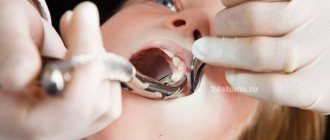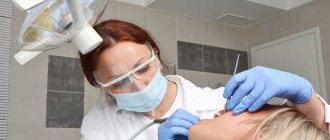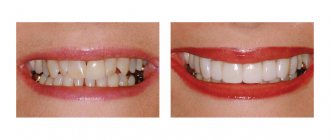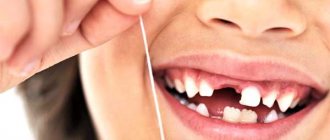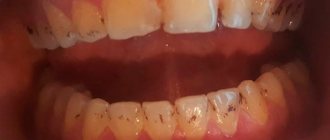- What to do if a child breaks a tooth?
- A child's tooth is dislocated.
- If a child knocks out a baby tooth, what should you do?
- Prevention of childhood dental injuries.
Children differ from adults by being more active and playful.
These properties allow them to quickly understand the world around them. But sometimes children's pranks lead to unpleasant consequences, such as a knocked out or chipped tooth. Injuries to the dentition can occur either due to negligence or as a result of weakening of the enamel. Whatever the reason, parents urgently need to solve this problem.
And the only sure way to avoid complications after a chipped tooth is to see a dentist.
When do baby teeth start falling out?
During the first three years of life, a child grows 20 baby teeth. At this time, a temporary bite is formed: it is distinguished by a pronounced anatomical shape, thin enamel, and susceptibility to caries. After the first three years, the roots of baby teeth slowly dissolve, making room for a permanent bite. From the age of 4-5 years, baby teeth begin to fall out, and this continues until the fifth or sixth grade of school.
In most cases, the process occurs calmly and does not require third-party intervention, including medical attention. Dentists strongly advise against rushing things.
Do you need pain relief?
Anesthesia when removing temporary units is necessary when they are pulled out before the roots are reabsorbed. Without anesthesia, the procedure will cause pain to the child, since there are many nerve endings in the oral cavity. When removing, the following anesthesia methods are used:
- General anesthesia. They are used only if the child has mental illness or other remedies do not work on him.
- Local anesthesia with spray or gel. The method is suitable if the unit begins to wobble and does not cause severe discomfort.
- Anesthetic injection. The injection is given in the gum. Anesthesia lasts longer than when using gels and sprays, and has a more pronounced analgesic effect.
Why shouldn't you remove baby teeth yourself?
Removal of a baby tooth is considered premature if more than a year remains before a new one appears. This period is difficult to predict accurately, but you can roughly estimate it using a graph with average indicators.
Premature removal of a baby tooth is dangerous because its neighbors will try to take the vacant space. The roots of permanent teeth that are about to emerge will become crowded. The bite will change, which will take a long time to correct. Moreover, there are several strict contraindications for extracting baby teeth:
- Acute inflammatory diseases of the oral cavity.
- Inflammatory diseases of the throat (ARVI, sore throat, etc.).
- It is not recommended to remove teeth for pathologies of the cardiovascular system, kidneys, central nervous system, blood diseases, vitamin deficiency and nutritional dystrophy.
So when your child's first baby teeth start to loosen, don't disturb them and let them fall out naturally. The child's body knows its business.
When a tooth is already loose, it needs to be cleaned very carefully so as not to rush things. If your child is still in kindergarten and his motor skills are not well developed, help him: take ASEPTA® Baby dental wet wipes and wipe the tooth (as well as its neighbors) from the top and sides.
Contraindications
- Acute inflammation in the mouth, such as candidiasis, gingivitis or stomatitis;
- Pneumonia, tonsillitis, whooping cough;
- Various tumors near the temporary tooth, when it needs to be removed along with it in the hospital.
It is recommended to remove temporary teeth only when the acute stage of dental disease has passed. During removal, it is necessary to take into account possible pathologies of the patient, such as cardiac pathologies, problems with blood vessels and the nervous system, kidney diseases and various blood diseases.
Indications for milk tooth extraction
However, there are several cases when teeth definitely need to be helped to fall out. For example:
- Bottle caries or other caries has damaged more than half of the tooth.
- The tooth has been loose for a long time, but cannot fall out. This makes it uncomfortable for the baby to chew.
- The tooth is broken, the sharp edge scratches the cheek or tongue.
- The root is affected by caries (there is a danger that it will damage the permanent tooth underneath).
- Pulpitis.
- There is inflammation or a cyst on the mucous membrane next to the tooth.
Do not make the decision to remove it yourself: if you see the symptoms listed above, contact your pediatric dentist. He will tell you what treatment is required.
Trying to remove baby teeth yourself at home is dangerous: their thin walls and long roots go too deep into the gums. If you pull out a tooth with a thread or other improvised methods, you can easily disrupt the growth of permanent teeth that are hidden under the milk teeth.
What to do if a child breaks a tooth?
The first thing to do is to calm the child and examine for other injuries that require urgent medical attention. If these are not observed, then rinse your baby’s mouth with water, blot the injury site with a clean napkin, and also try to find the chipped part of the tooth.
If the pain is severe, the child should be given a pain reliever. If a red dot is visible on the tooth, this means that the nerve has been exposed. In this case, you should not give your child cold or hot drinks and go to the dentist as soon as possible.
If there is no red dot on the damaged tooth, it has not moved, and the jaw can close normally, then there is no particular danger. Nevertheless, it is still necessary to see a doctor, since the tooth has lost its protective layer and is now more susceptible to infections and all kinds of diseases. Without proper treatment, the nerve may simply die, resulting in the loss of the entire tooth.
What to do after removing a baby tooth?
The dentist will provide detailed recommendations based on your child’s jaw development. Below are general tips that will help your gums recover as quickly as possible.
- After a baby tooth is removed, a blood clot appears in its socket, which helps the gum heal faster and protects it from dirt. Therefore, rinsing your mouth is not recommended. The clot may become dislodged.
- The tampon that the doctor left in your mouth should be carefully spat out after 20 minutes.
- Ask your child not to bite his cheek in the area of anesthesia. When it “comes off”, painful sensations may appear.
- For a couple of days it is better to abstain from hot foods and fermented milk products, which create an environment beneficial for bacteria.
- During the first week, you should avoid heavy physical activity (especially swimming and running).
- Do not go to the bathhouse or sauna for a week.
- On the first day, it is better to eat soft, cold food.
- Help your child brush his teeth. Use only a soft brush.
Causes
Complex cases include situations where the presence of a fragment is detected a significant period after surgery. This may be a consequence of the removal of a crumbled tooth, which has to be removed in parts - in such circumstances, it is recommended to take an x-ray to ensure that the cavity has been properly processed. Destructive processes can also occur in the root part:
- For fractures and other mechanical injuries;
- In case of significant destruction of the crown affecting the root;
- In inflammatory processes accompanied by the formation of phlegmon and cysts;
- Due to the incorrect position of the unit in the jaw region;
- With excessive mobility of the root part.
Additional difficulties in examining the extraction area arise when extracting units located in areas that are difficult to visualize. In addition, an adjacent element of the row that was subjected to indirect impact during the operation may crumble.
The fragments remaining after tooth extraction interfere with tissue regeneration, cause pain and lead to the development of inflammatory processes.
How to go to the dentist, remove a baby tooth and not scare your baby?
It is recommended that a child’s baby teeth be removed by pediatric dentists: it will be painless, safe and timely. For everything to go smoothly, a visit to the dentist should be associated with something pleasant and calm. Modern dentistry has a friendly atmosphere, new painkillers have appeared, and instruments (especially in children's offices) do not inspire fear.
Finally, our advice: don’t worry and don’t let your child worry. The calmer you are about going to the dentist, the calmer your baby will behave. Stay nearby in the dentist's office, because parental support is extremely important to him.
What to do in the first minutes if a child has a broken tooth?
First, calm down yourself and calm your child. If you have something cold on hand, it is good to immediately apply a compress to the injury site to relieve pain and prevent severe swelling (if the injury is not open).
For an open wound, clean it of large contaminants and cover it with a sterile gauze pad. Time is very important! The most important thing is to get to the dentist as quickly as possible! The doctor will conduct an examination, take an x-ray to see all damage to the hard and soft tissues surrounding the tooth and rule out a fracture of the jaw bones, as well as carry out the necessary treatment.
In the future, such teeth require dynamic observation at a time determined by the dentist. With timely treatment and regular monitoring, the prognosis is favorable.
Difficult case
Unfortunately, quite often patients come to the dental clinic too late, when the pathological process in the oral cavity has reached an advanced stage. This is why tooth extraction becomes a difficult task. This may be due to the presence of a strong inflammatory process, making visualization of the unit difficult. A fragment may remain in the hole only due to the complexity of the operation.
There are also cases when a tooth splits into several parts during extraction. As a result, it has to be removed piece by piece. If even one piece is left in the gum cavity, this can lead to serious consequences. To ensure that the tooth has been completely removed, your dentist may order an x-ray.
There are cases when the root of a unit splits into many small parts, that is, crumbles. This can occur as a result of serious injury, fracture, or due to the presence of acute inflammatory processes in the oral cavity, for example, cysts, phlegmon, osteomyetitis or abscesses. Often the root splits due to its strong mobility or incorrect location relative to other units.
Symptoms
Characteristic signs indicating the presence of a fragment are:
- Prolonged redness of the gum tissue in the operated area;
- Increase in temperature several days after the intervention;
- Feeling of aching joints, chills, pungent breath;
- Discharge of purulent exudate, pain in a calm state;
- Prolonged persistence of tissue swelling.
It is worth noting that some of these symptoms can be regarded in the first days as a normal reaction of the body, but their persistence 5-6 days after surgery is a reason to consult a doctor.
How temporary teeth are removed
Like any other medical procedure, tooth extraction has a clearly developed scheme and is carried out in several stages:
- Local anesthesia is the most common form of anesthesia. Specialists turn to more serious methods (general anesthesia) only in extreme cases: pathologies of the child’s psyche, purulent processes in the oral cavity, an allergic reaction and a history of individual intolerance to local anesthetics;
- Application of forceps to the crown;
- Rocking baby tooth;
- Its removal from the hole;
- Removal of fragments and granulations remaining in the socket;
- Packing the wound surface.
In order for both the doctor and the little patient to feel comfortable, parents must prepare the child and explain to him the importance of this procedure. Mental preparation is an important aspect of treatment.
Possible reasons why a child’s baby tooth has fallen out
The main reason for the loss of baby teeth is the eruption of permanent teeth. The process of replacing baby teeth is preceded by the resorption of their roots. After root loss, the baby tooth becomes loose and falls out. Most often, the process does not cause the child significant discomfort or pain, and the vacated space is subsequently filled with the erupting permanent incisor.
Attention! The replacement of baby teeth with permanent ones is a natural process established by nature. Root teeth are stronger and more resilient, they are distinguished by the hardness and density of the enamel, therefore making it easier for the child to adapt to adult food.
The first loss of baby teeth occurs after the child reaches the age of six, which is considered the norm in dentistry. It takes 6 to 8 years for permanent teeth to form.
This is exactly how long it will take for 20 baby teeth to fall out and 32 root teeth to erupt. But due to the individual characteristics of each individual child’s body, minor deviations from the established schedule are allowed.
However, if your first baby tooth falls out at age 4 or even at age 5, you should consult a specialist , as this may be due to improper oral care. Early loss of baby teeth, as well as delays in the schedule, is fraught with serious defects in the developing dentition, and therefore requires supervision by a pediatric dentist.
